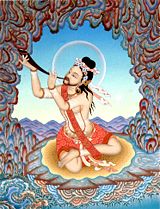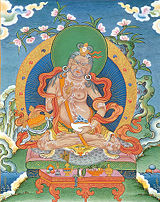Naropa
From Buddha World
Nāropā or Naropa (Prakrit; Sanskrit: Nādapradā, 956-1041) was an Indian Buddhist yogi, mystic and monk. He was the disciple of Tilopa and brother, or some sources say partner and pupil, of Niguma. Naropa was the main teacher of Marpa, the founder of the Kagyu school of Tibetan Buddhism. As an Indian tantric Buddhist, he has a place in Vajrayana Buddhism as a whole, but he is particularly renowned in Tibetan Buddhism via his name being attached to the six yogas of Naropa, a suite of advanced yogic practices for the attainment of skills relevant to the completion stage of anuttarayogatantra.
Biography
Naropa was born a high status Brahmin but from an early age showed an independent streak, hoping to follow a career of study and meditation. Succumbing to his parents wishes, he agreed to an arranged marriage with a young brahmin girl. After 8 years they both agreed to dissolve their marriage and become ordained. At the age of 28 Naropa entered the famous Buddhist University at Nalanda where he studied both Sutra and Tantra. He gained the reputation as a great scholar and faultless debater, essential at that time as the tradition of debate was such that the loser automatically became a student of the winner. He eventually gained the title "Gatekeeper of the North"; engaged in many debates, taught and won many students. According to his Tibetan namthar, or spiritual biography, one day whilst he was studying a dakini appeared to Naropa and asked if he understood the words of the dharma, Buddha's teachings. He replied that he did and when she seemed happy with his response, he added that he also understood their meaning. At this point the dakini burst into tears, stating that he was a great scholar, but also a liar, as the only one who understood the teachings was her brother Tilopa. On hearing the name Tilopa, he experienced an intense feeling of devotion, and Naropa realised he needed to find the teacher in order to achieve full realization. He abandoned his studies and position at the university and set out to find Tilopa. Naropa then underwent what is known as the twelve minor hardships in his quest to find his teacher, all the hardships being hidden teachings on his path to enlightenment. When he finally met Tilopa, he was given the four complete transmission lineages which he then began to practice. While studying and meditating with Tilopa, Naropa had to undergo a further twelve major hardships, trainings to overcome all the obstacles on his path, culminating in his full realization of Mahāmudrā. Naropa spent a total of twelve years with Tilopa. Later in his life Naropa stayed in Phullahari, where he died aged 85. One of the few reliable historical accounts of him comes from a Tibetan translator named Ngatso Lotsawa, who made an effort to visit Naropa at the monastery of Phullahari while waiting to visit with Atisha at Vikramashila. He records:
- I thought I would go see the Lord Naropa, since his reputation was so great. I went east from Magadha for a month, as I had heard that the Lord was staying in the monastery known as Phullahari. Very great merit arose from being able to go see him. On the day I arrived, they said some feudal prince had come to pay homage. So I went to the spot, and a great throne had been erected. I sat right in front of it. The whole crowd started buzzing, "The Lord is coming!" I looked and the Lord was physically quite corpulent, with his white hair [stained with henna] bright red, and a vermilion turban on. He was being carried [on a palanquin] by four men, and was chewing betel-leaf. I grabbed his feet and thought, "I should listen to his pronoucements!" Stronger and stronger people, though, pushed me further and further from his feet and finally I was tossed out of the crowd. So, there I saw the Lord's face, but did not actually hear his voice.
Legacy
Naropa is remembered for his trust and devotion to his teacher, which according to his namthar enabled him to attain enlightenment in one lifetime. He is also remembered as part of the 'Golden Garland', meaning a lineage holder of the Tibetan Buddhist Kagyu school, and was considered an accomplished scholar. A great meditator, Naropa is best known for having enumerated and developed the six yogas of Naropa. These practices were designed to help achieve a more rapid attainment of enlightenment. Many subsequent Kagyus Karmapas have been particularly adept at one or more of these six yogic practices, which in Vajrayana tradition were given by the Buddha, and have been passed on through an unbroken lineage via Tilopa to Naropa and up to the present day. Naropa is considered one of the eighty-four mahasiddhas, the 'saints' of tantric Buddhism. Naropa University in Colorado, USA was named in his honour.



 По-Русски
По-Русски
